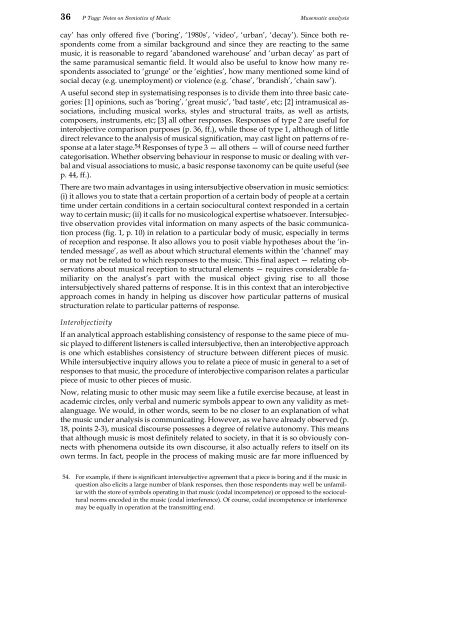Introductory notes to the Semiotics of Music - Philip Tagg's home page
Introductory notes to the Semiotics of Music - Philip Tagg's home page
Introductory notes to the Semiotics of Music - Philip Tagg's home page
You also want an ePaper? Increase the reach of your titles
YUMPU automatically turns print PDFs into web optimized ePapers that Google loves.
36 P Tagg: Notes on <strong>Semiotics</strong> <strong>of</strong> <strong>Music</strong> Musematic analysis<br />
cay’ has only <strong>of</strong>fered five (‘boring’, ‘1980s’, ‘video’, ‘urban’, ‘decay’). Since both respondents<br />
come from a similar background and since <strong>the</strong>y are reacting <strong>to</strong> <strong>the</strong> same<br />
music, it is reasonable <strong>to</strong> regard ‘abandoned warehouse’ and ‘urban decay’ as part <strong>of</strong><br />
<strong>the</strong> same paramusical semantic field. It would also be useful <strong>to</strong> know how many respondents<br />
associated <strong>to</strong> ‘grunge’ or <strong>the</strong> ‘eighties’, how many mentioned some kind <strong>of</strong><br />
social decay (e.g. unemployment) or violence (e.g. ‘chase’, ‘brandish’, ‘chain saw’).<br />
A useful second step in systematising responses is <strong>to</strong> divide <strong>the</strong>m in<strong>to</strong> three basic categories:<br />
[1] opinions, such as ‘boring’, ‘great music’, ‘bad taste’, etc; [2] intramusical associations,<br />
including musical works, styles and structural traits, as well as artists,<br />
composers, instruments, etc; [3] all o<strong>the</strong>r responses. Responses <strong>of</strong> type 2 are useful for<br />
interobjective comparison purposes (p. 36, ff.), while those <strong>of</strong> type 1, although <strong>of</strong> little<br />
direct relevance <strong>to</strong> <strong>the</strong> analysis <strong>of</strong> musical signification, may cast light on patterns <strong>of</strong> response<br />
at a later stage. 54 Responses <strong>of</strong> type 3 — all o<strong>the</strong>rs — will <strong>of</strong> course need fur<strong>the</strong>r<br />
categorisation. Whe<strong>the</strong>r observing behaviour in response <strong>to</strong> music or dealing with verbal<br />
and visual associations <strong>to</strong> music, a basic response taxonomy can be quite useful (see<br />
p. 44, ff.).<br />
There are two main advantages in using intersubjective observation in music semiotics:<br />
(i) it allows you <strong>to</strong> state that a certain proportion <strong>of</strong> a certain body <strong>of</strong> people at a certain<br />
time under certain conditions in a certain sociocultural context responded in a certain<br />
way <strong>to</strong> certain music; (ii) it calls for no musicological expertise whatsoever. Intersubjective<br />
observation provides vital information on many aspects <strong>of</strong> <strong>the</strong> basic communication<br />
process (fig. 1, p. 10) in relation <strong>to</strong> a particular body <strong>of</strong> music, especially in terms<br />
<strong>of</strong> reception and response. It also allows you <strong>to</strong> posit viable hypo<strong>the</strong>ses about <strong>the</strong> ‘intended<br />
message’, as well as about which structural elements within <strong>the</strong> ‘channel’ may<br />
or may not be related <strong>to</strong> which responses <strong>to</strong> <strong>the</strong> music. This final aspect — relating observations<br />
about musical reception <strong>to</strong> structural elements — requires considerable familiarity<br />
on <strong>the</strong> analyst’s part with <strong>the</strong> musical object giving rise <strong>to</strong> all those<br />
intersubjectively shared patterns <strong>of</strong> response. It is in this context that an interobjective<br />
approach comes in handy in helping us discover how particular patterns <strong>of</strong> musical<br />
structuration relate <strong>to</strong> particular patterns <strong>of</strong> response.<br />
Interobjectivity<br />
If an analytical approach establishing consistency <strong>of</strong> response <strong>to</strong> <strong>the</strong> same piece <strong>of</strong> music<br />
played <strong>to</strong> different listeners is called intersubjective, <strong>the</strong>n an interobjective approach<br />
is one which establishes consistency <strong>of</strong> structure between different pieces <strong>of</strong> music.<br />
While intersubjective inquiry allows you <strong>to</strong> relate a piece <strong>of</strong> music in general <strong>to</strong> a set <strong>of</strong><br />
responses <strong>to</strong> that music, <strong>the</strong> procedure <strong>of</strong> interobjective comparison relates a particular<br />
piece <strong>of</strong> music <strong>to</strong> o<strong>the</strong>r pieces <strong>of</strong> music.<br />
Now, relating music <strong>to</strong> o<strong>the</strong>r music may seem like a futile exercise because, at least in<br />
academic circles, only verbal and numeric symbols appear <strong>to</strong> own any validity as metalanguage.<br />
We would, in o<strong>the</strong>r words, seem <strong>to</strong> be no closer <strong>to</strong> an explanation <strong>of</strong> what<br />
<strong>the</strong> music under analysis is communicating. However, as we have already observed (p.<br />
18, points 2-3), musical discourse possesses a degree <strong>of</strong> relative au<strong>to</strong>nomy. This means<br />
that although music is most definitely related <strong>to</strong> society, in that it is so obviously connects<br />
with phenomena outside its own discourse, it also actually refers <strong>to</strong> itself on its<br />
own terms. In fact, people in <strong>the</strong> process <strong>of</strong> making music are far more influenced by<br />
54. For example, if <strong>the</strong>re is significant intersubjective agreement that a piece is boring and if <strong>the</strong> music in<br />
question also elicits a large number <strong>of</strong> blank responses, <strong>the</strong>n those respondents may well be unfamiliar<br />
with <strong>the</strong> s<strong>to</strong>re <strong>of</strong> symbols operating in that music (codal incompetence) or opposed <strong>to</strong> <strong>the</strong> sociocultural<br />
norms encoded in <strong>the</strong> music (codal interference). Of course, codal incompetence or interference<br />
may be equally in operation at <strong>the</strong> transmitting end.














